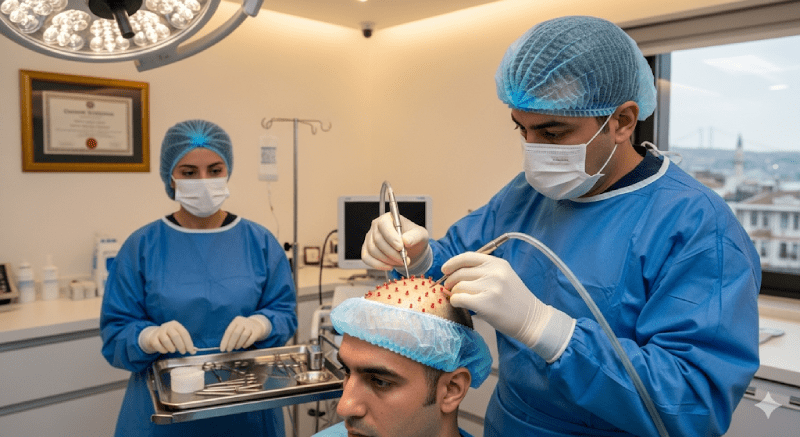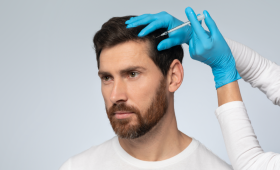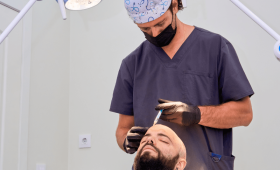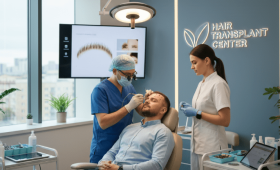What is Hair Transplantation?
Hair transplantation is a procedure in which healthy hair follicles are transplanted from an area of the head, typically the back, to areas with thinning or complete hair loss. These follicles are genetically resistant to balding, so they continue to grow permanently in their new location. The procedure is performed under local anesthesia, so the patient does not feel any pain, and the transplanted hair grows in a way that is compatible with your natural hair. The goal is to permanently fill in bald areas to achieve a fuller and more natural look.
What are the Types of Hair Transplantation?
Hair transplantation is divided into different methods depending on the technique used. Here are the most common types of hair transplantation:
1. FUE (Follicular Unit Extraction) Method
FUE is the most preferred and modern hair transplantation technique today. In this method, hair follicles are harvested one by one from the donor area (usually the back of the head) using a special micromotor or manual tools. These follicles are then transplanted into channels opened in the bald areas.
Features:
- No scarring: Since the follicles are harvested individually, there are no stitch marks in the donor area; only millimetric scars remain and heal in a short time.
- Fast recovery: The post-operative recovery period is much shorter.
- Natural look: A very natural result is achieved when hair follicles are placed at the correct angles.
2. Sapphire FUE Method
Sapphire FUE is an improved version of the FUE technique with special sapphire tips. In this method, the channel-opening stage is performed with special blades made of sapphire instead of metal slits. These blades create V-shaped micro-channels, minimizing tissue damage.
Features:
- Minimal tissue damage: Less tissue damage occurs thanks to the sharper and smoother sapphire tips.
- Faster recovery: The healing process is accelerated because the micro-channels opened are smaller.
- More natural and dense transplantation: It allows for denser and more accurate angled channel opening, resulting in a more natural and fuller look.
3. DHI (Direct Hair Implantation) Method
DHI is considered a variation of FUE. This method uses a special tool called the Choi Implanter Pen. With this pen-like tool, the hair follicles are harvested from the donor area and the channel-opening and follicle-placement procedures are done simultaneously.
Features:
- Faster process: The survival rate of the follicles can be higher as they are not kept waiting.
- Denser transplantation: Denser implantation can be performed because the channels are smaller.
- Possibility of unshaven transplantation: For suitable patients, the procedure can be performed without completely shaving the donor area.
4. FUT (Follicular Unit Transplantation) Method
FUT is an older method and is used less today with the widespread adoption of FUE. In this technique, a strip of tissue is cut and removed from the donor area. The hair follicles within this strip are then separated one by one under a microscope and transplanted into the bald areas.
Features:
- Stitch scar: A permanent stitch scar forms in the donor area because a strip is removed.
- More follicles transplanted: More hair follicles can be harvested in a single session.
- Longer recovery: The recovery period is longer than with FUE and may involve more pain.
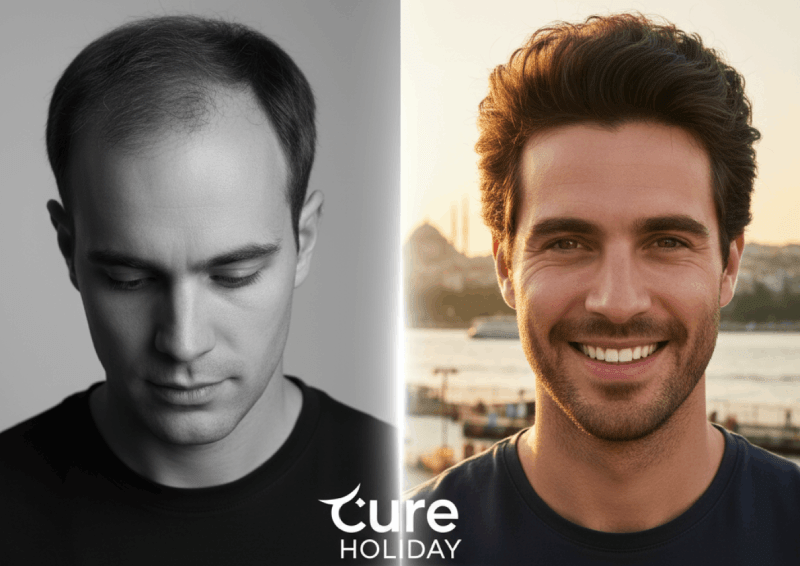
Who Can Get a Hair Transplant?
Hair transplantation offers an effective and permanent solution for individuals experiencing permanent hair loss. However, this operation may not be suitable for every type of hair loss or every individual. There are several factors to consider to determine if you are a suitable candidate for a hair transplant.
Basic Suitability Criteria
1. Age
It is expected that hair loss will stabilize, generally by the late 20s. For this reason, the ideal age range for hair transplant operations is usually 25 years and older. Transplants performed at a young age while hair loss is still progressing can lead to an unnatural appearance as the loss continues later on.
2. Type and Degree of Hair Loss
Hair transplantation is most suitable for androgenetic alopecia (male pattern baldness). This type of hair loss is genetic and typically causes permanent thinning and loss in the temples, crown, and hairline. Successful results can also be achieved in cases of hair loss due to scars or burns. This method is generally not suitable for conditions like alopecia areata or widespread hair shedding.
3. Donor Area
One of the most critical factors for the success of the operation is the presence of a sufficient and healthy donor area. The donor area is typically the back and sides of the head. The hair follicles in this region are genetically resistant to shedding. The density and quality of the hair in the donor area determine how many grafts (hair follicles) can be harvested and, consequently, how much of the recipient area can be covered.
Ideal Hair Transplant Candidates
- Individuals whose hair loss has stabilized.
- Those with sufficient density of donor hair on the back and sides of the head.
- Individuals with realistic expectations about the results they can achieve after the operation.
- People who do not have a chronic illness and are in good general health.
Unsuitable Conditions for a Hair Transplant
- Insufficient hair density in the donor area.
- Ongoing or unstabilized hair loss.
- Individuals with health problems such as uncontrolled diabetes, blood clotting disorders, or severe heart disease.
- Those experiencing hair loss due to autoimmune diseases like alopecia areata.
Expert Opinion is Important
The decision for a hair transplant must be made as a result of a detailed evaluation by a hair transplant surgeon or a dermatologist who is an expert in the field. Your specialist will analyze your hair and skin structure to determine the most suitable treatment method for you and decide whether the operation is appropriate.
Does Hair Transplantation Hurt?
Hair transplantation is actually a very comfortable procedure when it comes to the feeling of pain or ache, which is a topic that many people wonder about and fear. Contrary to popular belief, hair transplantation operations are not painful for the patient. The entire procedure is performed under local anesthesia, so the feeling of pain is minimized.
Anesthesia Stage
Before the procedure begins, the donor area (usually the back of the head) and the transplantation area are numbed with local anesthesia. This numbing process, because it is applied with very fine-tipped needles, may give a slight needle prick sensation. This feeling can be compared to anesthesia given at the dentist, and this stage is the most noticeable moment that can be felt throughout the entire operation. After the anesthesia takes effect, no pain or ache is felt during the operation.
Feelings During the Procedure
Thanks to local anesthesia, the patient remains awake during the hair transplantation procedure but does not feel any pain. There may only be a feeling of pressure or touch in the area where the operation is performed. During this process, patients can usually listen to music, watch movies, or chat comfortably. All stages, such as taking hair follicles from the donor area and opening the channels, are completed without pain.
Post-Procedure Period
In the first few days after hair transplantation, it is normal to feel a slight discomfort when the effect of the anesthesia wears off. This discomfort can be described as a slight ache or tension rather than pain. Thanks to the painkillers and other medications your doctor will prescribe, this discomfort can be easily controlled. In addition, post-operative conditions such as swelling, slight bruising, or itching may be seen, but these are also temporary and manageable.
In conclusion, the hair transplantation operation is a painless process thanks to anesthesia. The most noticeable feeling is a slight stinging sensation felt during the anesthesia. The minor discomforts after the procedure can be easily alleviated with medications used with the doctor’s advice.

Painless Hair Transplant in Turkey
In Turkey, hair transplantation has become a procedure with almost no pain, thanks to advanced techniques and modern anesthesia methods. The stage where the most pain was felt in traditional methods—local anesthesia with needles—can now be eliminated with special systems that have been developed.
Here is what you need to know about painless hair transplantation treatment in Turkey:
1. Needle-Free Anesthesia (Comfort-in System)
The only pain felt during a hair transplant is usually from the needle injections for local anesthesia. “Comfort-in” or similar needle-free anesthesia devices completely eliminate this problem. In this technique, a pressurized system is used to spray the local anesthetic medication under the skin without using a needle. This allows patients to complete even the pre-procedure injection phase without feeling any pain.
2. Hair Transplantation with Sedation
Hair transplantation with sedation is an ideal option for people with a low pain threshold or a fear of needles. In this method, a mild sedative is administered intravenously by an anesthesiologist. The patient remains comfortable and relaxed throughout the entire procedure due to this light state of sleep. With the effect of sedation, neither the anesthesia needles nor any pain or discomfort is felt during the operation. While the patient remains conscious, they go through the operation without any anxiety.
3. Modern Techniques Applied
The most commonly used FUE and DHI techniques today are much less invasive than older methods and naturally cause less pain.
- FUE (Follicular Unit Extraction): Since the hair follicles are harvested one by one from the donor area, no incisions or stitches are made. This speeds up the healing process and minimizes pain.
- DHI (Direct Hair Implantation): Using a special tool called the “Choi Implanter Pen,” the channel-opening and hair follicle placement procedures are done simultaneously. This minimizes bleeding and tissue damage, and post-operative pain is almost not felt at all.
When these modern techniques are combined with needle-free anesthesia or sedation, the hair transplantation procedure becomes a completely comfortable experience for patients. Any mild soreness or tension that may be felt after the operation can be easily controlled with simple painkillers.
First Wash and Care After Hair Transplant
The first wash after a hair transplant is a critical step in the healing process and must be done correctly. The first wash is usually performed 24 to 48 hours after the procedure, or within the time frame specified by your doctor, by a specialist team at your clinic. You can then begin subsequent washes at home, following your doctor’s instructions.
How is the First Wash Performed?
The first wash typically involves these steps:
- Application of Softening Lotion: First, a special softening lotion (usually in foam or spray form) is applied to the transplanted area. This lotion softens the scabs and makes them easier to shed. The lotion is left on for about 30 minutes.
- Washing: After this waiting period, the lotion and hair are rinsed with lukewarm water. The most important thing to pay attention to here is that the water should not be high-pressure and should not hit the transplanted area directly. You can apply the water by pouring or using a cup.
- Washing with Special Shampoo: Next, a special shampoo recommended by your doctor is lathered and applied to the hair and transplanted area with gentle dabbing motions. At this stage, you should never rub, scratch, or apply pressure.
- Rinsing: The shampoo is also rinsed off gently with lukewarm water.
- Drying: The hair should not be dried with a hairdryer but with a towel, gently dabbing it. It’s best to let it air dry if possible.
At-Home Care Routine
The care routine you follow in the days after the first wash will speed up your recovery and help you get the best results.
- Washing Frequency: It is usually recommended to wash every day for the first 10-15 days. This helps the scabs fall off faster and reduces the risk of infection.
- Products to Use: Continue to use the special shampoo and lotions provided by your doctor. These products are specially formulated for the sensitive area and contribute to the healing process.
- Application Technique: When washing, be careful to still use light touches, without rubbing or pressing.
- Sun and Water: For the first few weeks, protect the transplanted area from direct sunlight and excessively hot water.
- Itching: The feeling of itching is normal, but you must avoid scratching. This can damage the grafts.
Important Points to Consider
- Hats and Caps: Avoid wearing tight hats or caps in the first few days without your doctor’s approval.
- Alcohol and Smoking: It is important to limit or completely stop alcohol and smoking during the healing process. These habits can negatively affect blood circulation.
- Strenuous Exercise: Avoid heavy sports and activities that cause excessive sweating for the first few weeks.
The Recovery Process After Hair Transplant
Hair transplantation is a popular cosmetic procedure used to restore hair to bald areas in a natural and permanent way. The success of the operation depends on the post-operative recovery process and the patient’s care during this period.
The recovery process can generally be divided into three main stages.
First 1-10 Days: Sensitivity and Scabbing
During this period, the transplanted area and the donor area (where the hair follicles were taken from) will be quite sensitive.
- First 24-48 Hours: Immediately after the operation, you may experience mild pain, swelling, and redness in the area. The pain relievers and ice packs recommended by your doctor will help alleviate these symptoms.
- First 3-5 Days: Small, red dots and scabs will start to form on the transplanted area. These scabs are important for the hair follicles to attach to their new locations.
- 7-10th Day: The first wash is usually done a few days after the operation, under your doctor’s supervision or as instructed by them. These washes help to soften and shed the scabs. It’s normal to feel an itchy sensation at this stage, but you must absolutely avoid scratching.
10-30th Day: The Shock Loss Period
This period is one of the most confusing stages of the recovery process.
- What is Shock Loss?: Within 2 to 4 weeks after the transplant, most of the transplanted hair follicles will fall out. This is a completely normal and expected reaction of the hair follicles to the trauma, as they enter a resting phase.
- Don’t Worry: Shock loss does not mean that the hair follicles are permanently lost. Only the hair shafts fall out, while the roots remain under the skin and go into a resting state.
3-12 Months: New Hair Growth and Thickening
This stage requires patience and is the most exciting period.
- 3rd Month: New, fine hairs begin to grow in place of the shed ones. The hair growth might be irregular.
- 6th Month: A significant portion of the new hair will have grown, and the hair shafts will begin to thicken. The appearance will noticeably improve at this stage.
- 12-18 Months: The final results of the hair transplant become clear during this period. The hair will have fully grown, thickened, and achieved a natural appearance.
What to Pay Attention to After Hair Transplant
To speed up the recovery process and achieve the best results, you need to pay attention to some important points:
- Follow Your Doctor’s Instructions: Take your prescribed medications regularly and follow the washing instructions meticulously.
- Avoid Alcohol and Smoking: Smoking and alcohol negatively affect blood circulation, slowing down the recovery process.
- Protect from the Sun: The sun’s harmful UV rays can damage the transplanted area. Protect yourself by wearing a hat or using an umbrella.
- Avoid Exercise: For the first few weeks, avoid strenuous exercise and activities that cause sweating.
Remember, every individual’s recovery process can be different. If you have any concerns during this period, do not hesitate to contact the clinic where you had the operation.
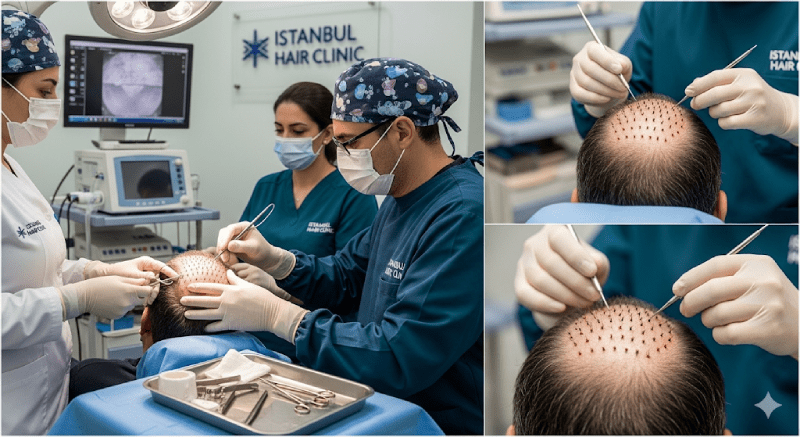
When Do Transplanted Hairs Grow?
One of the most common questions for people who have had a hair transplant is when the transplanted hairs will grow and when the final result will be achieved. This process is a journey that requires patience and progresses in stages.
First 1-3 Months: Shock Loss and First Signs
- Shock Loss (First 2-4 Weeks): The transplanted hair follicles enter a resting phase as a reaction to the trauma from the procedure. For this reason, a large portion of the transplanted hair shafts fall out. This does not mean the operation was unsuccessful; on the contrary, it is an expected and normal process. Only the hair shafts fall out, while the roots remain under the skin.
- Beginning of New Hair Growth (2-3rd Month): Following shock loss, the hair follicles start to become active again. The first hairs that emerge during this period are usually fine and weak. The hair growth may appear irregular and sparse.
3-6 Months: Dense Growth and Thickening
- Accelerated Growth (4-6th Month): This is when hair growth is at its densest. The new hairs become more noticeable and acquire a thicker structure. The growth rate of the hair increases, and the bald spots on the scalp begin to fill in visibly.
6-12 Months: Hair Maturation
- Final Results Become Clear (6-9th Month): At this stage, approximately 70-80% of the transplanted hair has grown. The hair thickens further, lengthens, and takes on a natural appearance.
- Full Result (12-18th Month): The final result of a hair transplant is typically reached within one year. During this process, all the hair has grown, achieving its full thickness and structure. The hair becomes indistinguishable from your natural hair and is permanent.
Main Factors Affecting the Operation Duration:
- Number of Grafts to be Transplanted: The most significant factor affecting the operation time is the number of hair roots (grafts) to be transplanted. If a larger area is to be transplanted and more grafts are required, the operation will take longer. For example, a 2000-graft transplant may take 4-5 hours, while a 4000-graft transplant may take 7-8 hours or longer.
- Method Used: The method used for hair transplantation also determines the duration. Different techniques, such as FUE (Follicular Unit Extraction) and DHI (Direct Hair Implantation), may require different timing based on the operation flow. While the DHI technique can complete the implantation process faster, placing the grafts one by one may require more attention and time.
- Experience of the Surgeon and Team: The experience of the surgeon and the team performing the operation can increase the efficiency of the procedure and shorten the duration. An experienced team can carry out the process more planned and faster.
How long does a hair transplant operation take?
An average hair transplant operation takes between 6 and 8 hours. This duration also includes the short rest and meal breaks given during the operation. While this duration can extend up to 10 hours for comprehensive operations on very large areas, it can decrease to 4 hours for smaller regions.
Hair Transplant and Turkey
Hair transplant is a highly effective and permanent solution for people experiencing hair loss. Turkey has a worldwide reputation for hair transplantation and is known as the “Hair Transplant Capital” in this field. There are many factors that make Turkey a popular destination for hair transplants.
Why Should You Choose Turkey?
- Expert and Experienced Surgeons: Hair transplant clinics in Turkey work with expert and experienced surgeons who use the latest technologies like FUE (Follicular Unit Extraction) and DHI (Direct Hair Implantation). These specialists ensure that you achieve natural and aesthetic results with high success rates.
- Affordable Prices: Hair transplant costs in Turkey are much more economical compared to many countries in Europe and North America. This means you can receive quality service at a more affordable price. Prices are often offered in packages that include the surgery itself, accommodation, and transfers.
- Quality Service and Packages: Most Turkish clinics offer comprehensive packages to their patients. These packages typically include the surgery, accommodation, airport transfers, post-operative care products, and consultation services. This ensures that the entire process is smooth and comfortable.
- Tourism Opportunities: You can turn your hair transplant surgery into a holiday opportunity filled with historical and cultural richness. Especially in major cities like Istanbul, you can visit many tourist attractions during your treatment.
How Does the Hair Transplant Process Work?
- Consultation: The first step is to contact your clinic for an initial consultation. During this process, your hair loss condition is evaluated, and the most suitable transplant method for you is determined.
- Operation Day: The operation usually takes one day and is performed under local anesthesia. This way, you do not feel any pain during the procedure. Surgeons take hair follicles from the donor area (usually the back of the head) and transplant them one by one into the balding area.
- Post-Operative Care: The first few days after surgery are of critical importance. Your clinic will give you detailed instructions on how to wash your hair, which products to use, and what precautions to take. Side effects such as swelling or redness may be seen in the first few weeks, but they will subside over time.
- Results: The transplanted hairs usually fall out within the first few weeks, but this is a normal process. The permanent results appear within 6 to 12 months, and the transplanted hairs continue to grow permanently.
How to find the best hair transplant clinics in Turkey?
1. Start Your Research
Conduct detailed online research. Begin by using keywords like “best hair transplant clinics in Turkey” or “Istanbul hair transplant” in search engines. Check the clinics’ websites, social media accounts (especially Instagram and Facebook), and patient reviews. Before and after photos and patient testimonials on their websites usually provide a good idea of the clinic’s quality.
2. Check for Certification and Experience
Verify if the clinics have international accreditations. Clinics accredited by international healthcare organizations like JCI (Joint Commission International) show they meet specific quality standards. Also, the experience of the doctors and surgeons is very important. Try to find out about the doctors’ specializations, how many years they’ve been working in this field, and the number of operations they have performed.
3.Patient Reviews and References
Focus on genuine patient reviews. Platforms like forums, Google Reviews, and Trustpilot are where patients share their experiences. The reviews written here can paint a more honest picture of the clinics. However, be cautious of fake reviews. If possible, try to directly contact people who have undergone the operation.
4. Service Quality and Price Comparison
Price should not be the only deciding factor. Very low prices can often be a sign that quality is being compromised. Compare the contents of the service packages offered by the clinics (pre-operative consultation, post-operative care, accommodation, and transfer services, etc.) and the techniques used (such as FUE, DHI). Try to make a decision by considering the balance between price and performance.
5. Get a Consultation
Get online consultations from several different clinics. Most clinics offer free online consultations to potential patients. During these consultations, you can get a hair analysis, see how the doctor answers your questions, and ask all the questions on your mind about the clinic. This process will give you important clues about the professionalism and patient communication of the clinic.

How to Find the Best Hair Transplant Doctors in Turkey?
Turkey has become a global brand in the field of hair transplantation. Behind this popularity lie both experienced doctors and clinics equipped with state-of-the-art technology. However, it can be difficult to find the right specialist among so many options. Here are important steps to guide you through this process:
1. Doctor and Clinic Research
- Certifications and Experience: Pay attention to the experience and training of the doctor or surgeon who will perform the hair transplant. Having internationally recognized certifications (e.g., membership in the ISHRS – International Society of Hair Restoration Surgery) is an advantage.
- Technological Equipment: Research whether the techniques used (FUE, DHI, Sapphire FUE, etc.) and the equipment in the clinic are up-to-date. Technology directly affects the quality and comfort of the procedure.
2. Patient Reviews and References
- Real Stories: Examine patient experiences on social media platforms, forums, and places like Google reviews. These reviews provide important clues about the doctor’s and clinic’s service quality, communication skills, and results.
- Before and After Photos: Do not hesitate to ask for examples from the doctor’s previous operations. These photos are the best evidence of the naturalness and density of the results obtained.
3. Initial Consultation and Communication
Hair transplantation is a personalized process. Therefore, your initial consultation with the doctor is very important. During this meeting, pay attention to the following:
- Clear Information: Evaluate whether the doctor provides you with transparent and understandable information about your hair structure, your suitability for the transplant, and how realistic your expectations are.
- Opportunity to Ask Questions: You should be able to ask all the questions you have. (e.g., “How long does the recovery process take?”, “Will there be pain after the procedure?”, “What is the required number of donor hairs?”)
4. Process Management and Comfort
A hair transplant operation is not just about the procedure; it also includes many details such as accommodation, transfers, and post-procedure follow-up. At this point, it can be beneficial to use a service that makes this entire process easier for you.
One of the organizations that can help you in this process is Cure Holiday. Cure Holiday collaborates with the best and most reliable hair transplant specialists in Turkey to offer you comprehensive packages. These packages typically include:
- Appointments with the Best Doctors: It allows you to work with expert and internationally recognized doctors.
- Full Organization: It arranges all the details for you, such as planning your operation day, airport transfers, and accommodation.
- Post-Procedure Follow-up: It follows up on your recovery process after the operation and answers all the questions on your mind.
Starting your hair transplant journey with Cure Holiday ensures you can navigate the entire process safely and comfortably. With our expertise and support, you’ll be taking the right step toward achieving your dream results.
Hair Transplant Costs in Turkey
Hair transplant costs in Turkey vary depending on a number of factors, so it’s difficult to give a definitive price. However, it’s possible to determine a general cost range and explain the factors that influence these prices.
Factors Affecting the Cost
- Number of Grafts to be Transplanted: A graft is a piece of tissue containing one or more hair follicles. The number of grafts is the most important factor directly affecting the cost of a hair transplant. The more grafts to be transplanted, the higher the cost.
- Method Used: There are different methods used in hair transplantation, such as FUE (Follicular Unit Extraction) and DHI (Direct Hair Implantation). DHI is generally a more delicate and intensive procedure, so it can be more expensive than FUE.
- Clinic and Doctor’s Experience: The reputation, experience, and success rates of the clinic and surgeon performing the hair transplant can affect prices. A well-known clinic and doctor specializing in the field may have higher prices.
- Clinic Location: Clinics in major cities like Istanbul, Ankara, or Izmir generally have higher prices than those in smaller cities.
- Package Content: Many clinics offer packages that include additional services besides the hair transplant, such as accommodation, transfers, post-operative care products, and medications. These services can increase the total cost.
Cost Range
Hair transplant costs in Turkey are usually determined on a per-graft or package price basis. Per-graft prices offer a more transparent calculation, while package prices are a more comprehensive option that covers the entire process.
- Per-graft costs can range from $1 to $3.
- The total cost for an average hair transplant procedure is typically between $2,000 and $5,000. For more extensive procedures, this price can go up to $7,000.
It’s important to remember that these costs are much more affordable compared to prices in Europe and the US. This has made Turkey a popular destination for hair transplant tourism.
For the most accurate pricing, it’s best to contact a few different clinics and get a personalized price quote for your specific situation.
Hair Transplant Guide: A City-by-City Analysis in Turkey
Turkey has a worldwide reputation in the field of hair transplantation. Many cities in the country offer attractive options for both local and international patients, with their modern clinics, experienced surgeons, and affordable prices. Here is a detailed guide to the most popular cities for hair transplantation and what they offer.
Istanbul: The World Capital of Hair Transplantation
Istanbul is the first city that comes to mind for hair transplantation and is a global leader in this field.
- Advantages:
- Wide Range of Options: There are hundreds of hair transplant clinics and hospitals, allowing you to find an option that suits every budget and expectation.
- Experienced Surgeons: Many surgeons and teams who are experts in their field and internationally recognized serve here.
- Latest Technology: The most up-to-date hair transplant techniques (FUE, DHI, Sapphire FUE) and equipment are used.
- Package Deals: Many clinics offer comprehensive packages that include accommodation, transfers, and even city tours.
- Things to Consider: There can be significant differences between prices and quality. It is important to do extensive research before making a decision.
Izmir: The Pearl of the Aegean
Izmir, the largest city in the Aegean Region, has recently come to the forefront in health tourism, especially in hair transplantation.
- Advantages:
- Accessibility: It offers easy access from both domestic and international locations.
- High-Quality Service: Although less crowded compared to Istanbul, the service quality is quite high.
- Calm Environment: Izmir’s relaxed and peaceful atmosphere is ideal for the post-operation recovery period.
- Things to Consider: The number of clinics is less than in Istanbul, so you may have fewer options.
Kusadasi: Combine a Holiday with Hair Transplantation
Kusadasi has become a preferred destination for hair transplantation, as well as a tourist paradise.
- Advantages:
- Tourism-Oriented Service: You can combine your hair transplant operation with an enjoyable holiday experience.
- Affordable Cost: It is possible to find more affordable prices compared to Istanbul.
- Beautiful Environment: The magnificent nature and sea of the Aegean add morale and motivation to your treatment process.
- Things to Consider: The number of clinics is much less than in Izmir and Istanbul. Options should be evaluated carefully.
Antalya: The Beauty Hub of the Mediterranean
Antalya, the capital of sun and sea, offers both treatment and relaxation opportunities for those who want to get a hair transplant.
- Advantages:
- Touristic Infrastructure: High-quality hotels and easy transportation options are available.
- Experienced Professionals: There are many doctors and clinics specialized in hair transplantation.
- Natural Beauty: You can enjoy the natural beauties of the Mediterranean during and after the treatment process.
- Things to Consider: Prices may increase during the high tourist season.
Mugla and Marmaris: A Recovery Surrounded by Nature
Mugla, and especially Marmaris, is ideal for those looking for a calmer environment surrounded by nature.
- Advantages:
- Peaceful Environment: It offers a relaxing recovery process away from stress.
- Personalized Service: In more boutique clinics, it is possible to see a personalized and sincere approach to the patient.
- Natural Beauties: Pine forests, bays, and clean air support the recovery process.
- Things to Consider: The number of clinics is quite low compared to big cities. Therefore, it is important to do your research in advance.
Although each city offers its unique advantages, it is important to consider the cost of the operation, the reliability of the clinic, the experience of the doctor, and the additional services offered when making the right choice.
Cure Holiday: A Life-Changing Hair Transplant Experience
If you’re struggling with hair loss and want to regain your self-confidence, Cure Holiday offers you a special solution. Promising more than just a hair transplant operation, Cure Holiday aims to transform this process into a comfortable vacation. Our clinic, which combines modern technology with experienced specialists, ensures you achieve natural and permanent results.
Why Choose Cure Holiday?
- Latest Technologies: We use the most current and effective methods in hair transplantation, namely FUE (Follicular Unit Extraction) and DHI (Direct Hair Implantation) techniques. Thanks to these methods, operations are performed with minimal invasiveness and without scars.
- Experienced and Expert Staff: Your operations are led by doctors and medical teams who have years of experience in this field and are trained to international standards.
- All-Inclusive Packages: We offer comprehensive packages for our international guests that include accommodation, transfers, and post-operative care, so you can simply focus on the excitement of getting your new hair.
- Natural and Permanent Results: A personalized plan is made for each patient, taking into account their hair structure and facial features. The creation of the most natural-looking hairline and the direction of the transplanted hair are designed specifically for you.
- Comfortable and Safe Environment: Our surgeries are performed in fully equipped clinics that adhere to the highest hygiene standards. We provide an environment where you will feel secure from start to finish.
The Impact of Hair Transplantation on Your Life
Hair transplantation is more than just an aesthetic procedure. A successful operation can improve your appearance in the mirror, helping you feel more confident and powerful in your social and professional life. With the natural-looking, thick, and healthy hair you’ll get from Cure Holiday, you can turn a new page in your life.
Contact Cure Holiday to get the hair of your dreams and enjoy this transformation. Our expert team is ready to answer your questions and create a personalized treatment plan for you.
